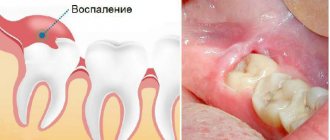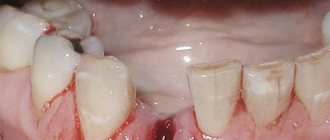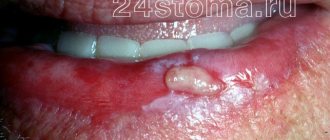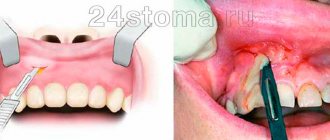Why are sutures required after wisdom tooth removal?
Extraction of the third molar requires suturing. It is not always possible to save the patient from the procedure described above. Even when working with high-quality equipment, a competent dentist will encounter problems. The third molar is secured with the help of two roots, the removal of which requires making a few incisions, and then removing the tooth body from the gum. Sutures are also applied if there are clinical signs of gum inflammation. Swelling is considered a natural process for the body, due to damage to the gums during incisions. The suturing procedure is also a preventive measure, which reduces the risk of infectious pathological syndrome; pathogenic bacteria do not penetrate into the open wound. The smaller the size of the wound, the lower the likelihood of infection, the age the rate of regeneration. Regardless of the type of thread used, suturing takes a short period of time. Self-absorbable threads are a more preferable option; they do not need to be removed and re-injure the gums.
How long will it take for gums to heal?
Healing times vary. They depend on two main factors:
- Difficulty of intervention. If the wisdom tooth has already erupted, then recovery occurs relatively quickly. If you had to make an incision in the gum and “cut down” part of the bone, it will take more time.
- Compliance with the doctor's recommendations, especially in the first 24 hours after the procedure.
In most cases, the function is restored within a week, and the person no longer experiences any discomfort. But some processes may continue to occur in the jaw for a long time. The bone is rebuilt, the shape of the face changes slightly.
The sutures usually dissolve on their own within 7–10 days. If non-absorbable suture material was used, the surgeon will invite you to remove the sutures after about a week.
How to understand that complications have arisen after suturing?
Alarming symptoms after removing the “eight” are as follows:
- heavy bleeding that lasts more than a day;
- severe pain, throbbing pain that prevents you from sleeping or leading a normal life;
- very large swelling;
- redness in the intervention area;
- blood in saliva in the first three days after the intervention;
- elevated body temperature.
In all these cases, you must consult your doctor. It is possible that stitches will have to be stitched again to avoid complications.
Indications for suturing
It is necessary to sew up the hole after tooth extraction if extraction is performed:
- dystopic and impacted dental units with a destroyed crown and severely curved roots,
- wisdom teeth
Another indication for wound suturing is to prevent severe bleeding. The doctor may decide to use stitches if:
- the patient is diagnosed with gingivitis or periodontitis,
- there is a suspicion of a blood clotting disorder.
Useful tips for oral care
- hold the cotton swab applied by the doctor for 20-30 minutes;
- within 2-3 hours after surgery, be sure to apply cold compresses to reduce tissue swelling;
- carry out oral baths (not to be confused with rinsing) with antiseptic drugs for 3-5 days: “Miramistin”, “Chlorhexidine 0.5%” or other drugs prescribed by a doctor can be used as medicinal solutions;
- after 3-5 days, start using a toothbrush - only a soft one for the operated area, as well as a new one, without bacteria on it. The teeth of the opposite jaw can be brushed immediately, the main thing is to avoid the area of the extracted tooth;
- chew food on the side opposite the injured area;
- You can drink water immediately, preferably warm;
- You can eat only after the anesthesia wears off, that is, after 2-3 hours;
- Lead a quiet lifestyle, try to avoid physical activity and heavy lifting for 5-7 days.
Types of suture materials
To close the hole after tooth extraction, modern dentistry uses various suture materials.
- Absorbable - sterile natural or synthetic threads that do not require removal. During the healing process, wounds resolve completely.
- Non-absorbable - silk and polymer threads. They are characterized by ductility and high strength. They need to be removed one week after the procedure.
The choice of suture material depends on the degree of tissue damage during surgery. After suturing, slight swelling and discomfort when chewing may be observed for 3 days. If the pain intensifies and the stitches come apart, you need to urgently seek help.
What not to do after suturing.
- don't rinse your mouth! Mouth baths in the first 3-5 days are more than enough;
- do not use hot compresses! This is fraught with the appearance of edema and the development of inflammation;
- do not create a vacuum in your mouth: do not puff out your cheeks, sneeze, blow your nose and spit very carefully;
- do not pick the wound, do not touch the clot with your tongue;
- do not drink or eat hot or cold food, only warm food;
- try to quit smoking for at least 2-3 days after surgery;
- Do not drink alcohol for 2-3 days - it does not promote tissue repair. Also rule it out if your doctor has prescribed a course of antibiotics;
- Do not overcool or overheat - give up sports exercises, swimming pools, saunas for 5-7 days.
What happens to the gum after removal?
The intervention associated with the operation requires sutures. After all, it is often impossible to remove a tooth that sits deep in the gum without surgical manipulation. The gums react quite sensitively to such things, they can become inflamed and almost always bleed.
If a wisdom tooth is to be removed, it is often necessary to cut a section of the gum and then apply stitches to quickly heal the wound. The gum is a mucous membrane, it covers the processes next to the lower and upper jaws, and is located directly next to the teeth.
After the dentist removes or simply pulls out a tooth, the gums become more sensitive and easily vulnerable to various microbes. For many people with periodontal disease, the gums are generally very irritated, and the slightest intervention leads to severe bleeding, purulent discharge and an unpleasant burning sensation.
Possible complications
Pain and swelling of the gums at rest, difficulty chewing, evening fever in the first two days after surgery and suturing are considered normal - this is a response to surgical trauma. If the symptoms increase, it means that a purulent complication is developing. A visit to the doctor is needed, opening the wound with removal of the suture threads, washing it, re-suturing or draining it, and taking antibiotics.
Complications arise when wound hygiene is not observed, infection occurs, or particles of a tooth or root are left in the wound.
Continued bleeding from the surgical area is possible if the stitches come apart.
Seam divergence
If the suture breaks apart after tooth extraction, this may indicate inflammation of the periosteum - periostitis.
When infected, the wound area swells, there is pain, discharge of pus, which can push out the threads, and the edges of the tissue diverge. Healing is delayed, and there is a risk of developing ugly scars.
If the sutures on the gums come apart, it is necessary to visit a surgeon to determine the cause and eliminate it with re-suturing of the wound in the oral cavity.
Maintains healthy gums by maintaining oral hygiene and following the dentist’s recommendations after any dental surgery.
Why do the seams come apart?
According to statistics, implant failure does not occur very often. However, such a complication can lead to serious consequences, the main one being non-healing of the structure. Let's look at the most common reasons for this phenomenon:
- Individual characteristics of the body, mainly the incorrect structure of the jaw or rejection of the material from which the thread is made can play a role.
- Not sterile conditions, due to which the wound got infected. Severe swelling and hyperemia occurs, which causes the seam to diverge.
- Neglecting advice from specialists. This may include errors in nutrition or lack of hygiene and medication measures.
- Poor quality surgical thread.
- Insufficient experience of the doctor, due to which the suturing process was performed incorrectly.
How long do you need to walk with stitches?
The patient's actions depend on the type of suture material used by the doctor. If the doctor used a non-absorbable option, a control appointment is scheduled after 7-10 days. During the examination, the surgeon assesses the speed of healing and the condition of the wound. Decides on the need to remove sutures.
The procedure is quick and atraumatic. The thread is cut into small segments and painlessly removed from the gums. If the patient experiences discomfort and anxiety, the doctor can use topical anesthesia.
Self-absorbing sutures disintegrate on their own in about three weeks. The patient may not notice the material disappearing from the wound. Especially if healing is going well and the hole is not bothering you.
When to remove gum sutures
Even if the wound was sutured with a self-absorbing thread, it is worth checking with your doctor whether it needs to be removed and when. The surgeon must ensure that the operation performed does not cause late complications. Therefore, you need a second visit to him after 7-10 days to determine how many days later to remove the sutures from the gums.
If there is no swelling, redness, or pain, the doctor will remove the stitches. If tissue healing is incomplete, you may need another visit in 2-3 days, during which the material used to close the wound will be removed.
Does it hurt to take it off?
When the suture thread is removed, the patient feels discomfort. Pain when pulling out suture material is rare, due to individual sensitivity or in the presence of a complication in the form of inflammation. If the patient's pain threshold is reduced, superficial anesthesia with Novocaine or Lidocaine spray is used.
How to remove sutures on the gums
Before removing stitches:
- The surgeon will treat the oral cavity with an antiseptic.
- Examine the mucous membrane of the oral cavity: it is necessary that there is no pain, fever, redness, swelling, and no fluid or pus is released from the wound area.
- The thread is cut with a special dental instrument. When the seam is continuous, the cut will be in several places; if it is intermittent, then all the stitches will be cut in half.
- Using fingers or tweezers, the surgeon will pull out pieces of thread and check how well the scar is formed on the wound.
After removing the stitches, the patient will rinse their mouth with an antiseptic.
For 1–3 days, unpleasant sensations in the jaw and gums are possible when moving.
The wound after tooth extraction heals completely within 2–3 weeks. In young people this process is faster. The sockets of single-rooted teeth can heal completely on the 14th day, multi-rooted ones - by the 20th day after surgery.
In case of purulent complications, healing will be delayed for a week for a single-rooted tooth, and 2 for a multi-rooted one.
The more traumatic the operation was, the larger the volume of tissue that was subjected to intervention, the longer the healing.
The surgeon still removes the absorbable sutures so that they, being on the gums for a long time, do not provoke inflammation.
Removing the suture material too early may prevent a clot from fully forming in the wound. In this case, inflammation is also possible.
Sometimes patients get in the way of the threads, and the question arises of how to remove the sutures from the gums on their own, at home, if there is no pain or swelling. What to do if the surgeon is far away, and it’s impossible to tolerate when the threads become hard and rub against the tongue or gums, causing irritation of the mucous membrane?
In principle, the stitches can be removed by the patient himself. But this is fraught with infection in the wound.
At home, you must follow all the rules of asepsis and antisepsis; you cannot keep your instruments sterile. Safe removal of the threads used to suture the gum wound is only possible by a dentist.











